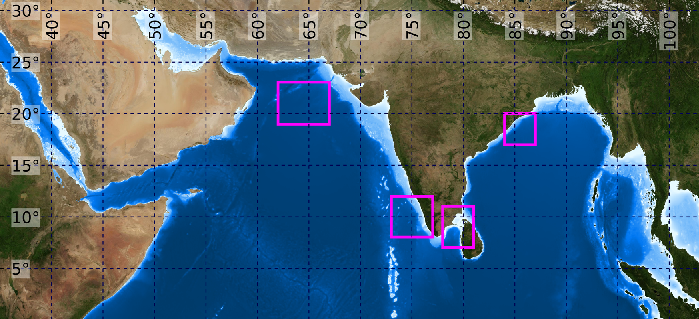ESSO - Indian National Centre for Ocean Information Services
(An Autonomous Body under the Ministry of Earth Sciences, Govt. of India)
Algal Bloom Information Service (ABIS)
ABIS Overview
The increasing frequency of algal blooms is a major concern due to its ill effects on fishery, marine life and water quality. INCOIS has developed a service for "Detection and Monitoring of Bloom in the Indian Seas". The targeted users are fishermen, fishery resource managers, researchers, ecologists and environmentalists. The duration and magnitude of algal blooms provide essential information for fishery management (Legendre 1990). Therefore, the bloom information also complements the Potential Fishing Zone advisories. INCOIS Algal Bloom Information Service (ABIS) provides near real time information on spatio-temporal existence and spread phytoplankton bloom over North Indian Ocean (0°-31°N & 35°E - 103°E). Daily satellite retrieved standard mapped images of sea surface temperature (Walton et al. 1998), chlorophyll (Hu et al. 2012), Algal Bloom Index - chlorophyll (Shanmugam 2011), Bloom Index (Ahn and Shanmugam 2006), rolling chlorophyll anomaly, rolling sea surface temperature anomaly, phytoplankton class/species (Dwivedi et al. 2015; Baliarsingh et al. 2017), phytoplankton size class (Sahay et al. 2017) and a composite image delineating bloom and non-bloom regions for the above mentioned region is being disseminated through ABIS. Inside the full domain, four regions have been identified as bloom hotspots viz. a) North Eastern Arabian Sea (19°N - 23°N & 62°E - 67°E) b) Coastal waters of Kerala (8°N - 12°N & 73°E - 77°E) c) Gulf of Mannar (7°N - 11°N & 78°E - 81°E) d) Coastal waters of Gopalpur (17°N - 20°N & 84°E - 87°E). The four hotspots are demarcated in magenta color box in the location map.
If the bloom is due to the presence of green or red Noctiluca then the bloom posses threat to the pristine condition of ambient water quality. Noctiluca, a mainly heterotrophic dinoflagellate, often causes intense red or green tides in coastal and offshore waters. When grazing on toxic phytoplankton, Noctiluca can transfer these toxins to higher trophic levels. Ammonia excretion by Noctiluca species during grazing, and particularly the release of high intracellular ammonia pools upon cell death, can result in fish mortality and toxicity to other organisms. The sudden collapse of these blooms also can generate hypoxic conditions in coastal regions (Harrison et al. 2011; Baliarsingh et al. 2016).
The marine pelagic food chain is based on trophic linkage between proliferation of diatom dominated phytoplankton assemblage, copepod (dominant zooplankters) production and fish (Cushing 1989; Legendre 1990). The diatoms constitute a major portion of the diet of copepods and therefore, diatom blooms are considered to support the cycle of secondary production and growth of fish larvae that depend predominantly on the egg and naupliar stages of copepods (Urban et al. 1992; Laabir et al. 1995; Turner 1984; Mann 1993; D'Silva et al. 2012). However, some diatom species can cause harmful algal blooms when associated with toxin production that results in poisoning of higher order marine mammals and birds (Hernandez-Becerril et al. 2007). Spasmodically, some diatom blooms also causes mechanical damage in fish gills, decline in dissolved oxygen levels, and result in asphyxia (Albright et al. 1993; Harris et al. 1995).
The area is designated under 'WATCH' if the sector has more than 50% bloom pixels. If the area has more than 75% bloom pixels, then that sector is put under 'WARNING'. The status of each sector is displayed by color code (green for normal, yellow for watch & red for warning).




